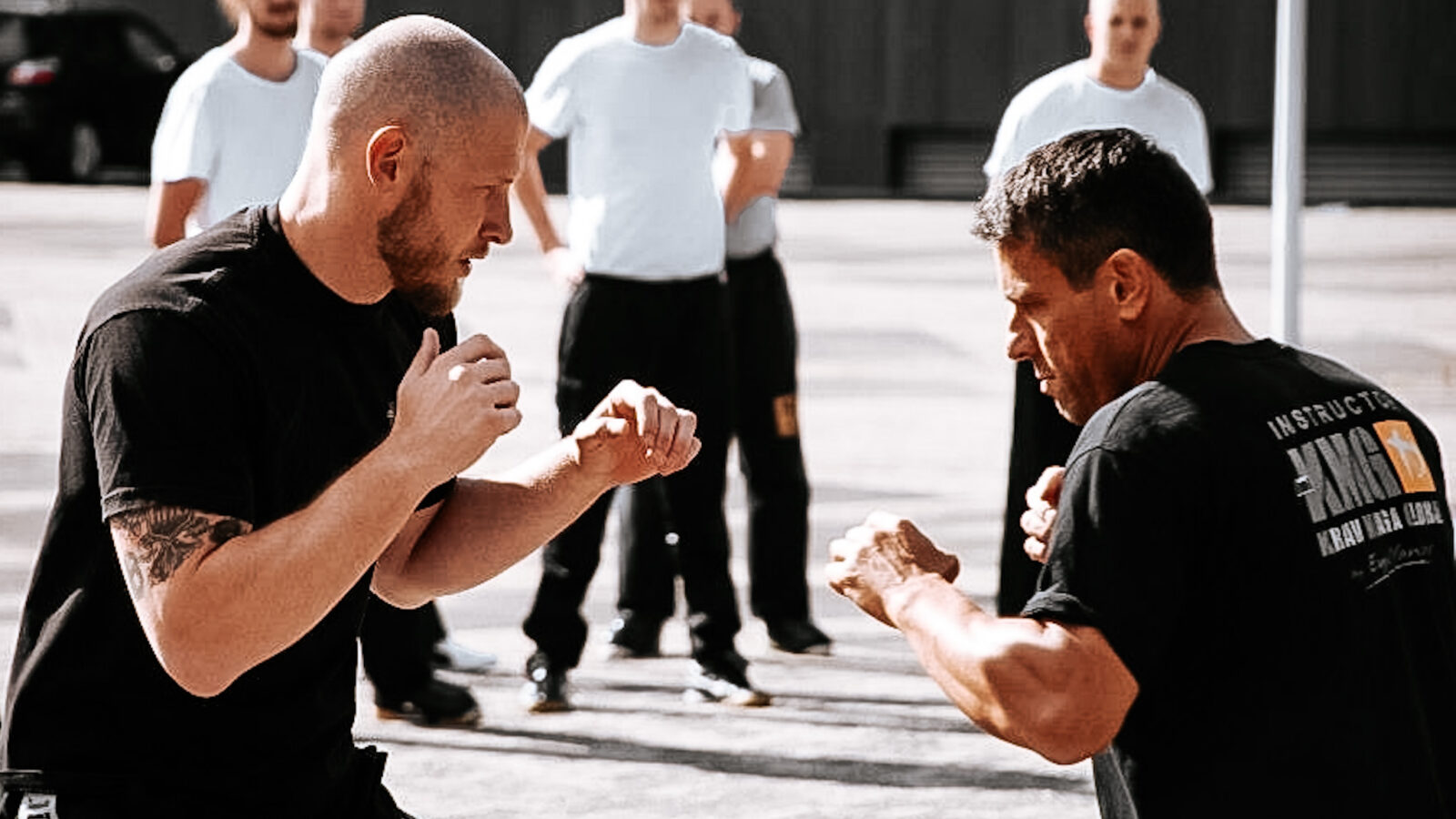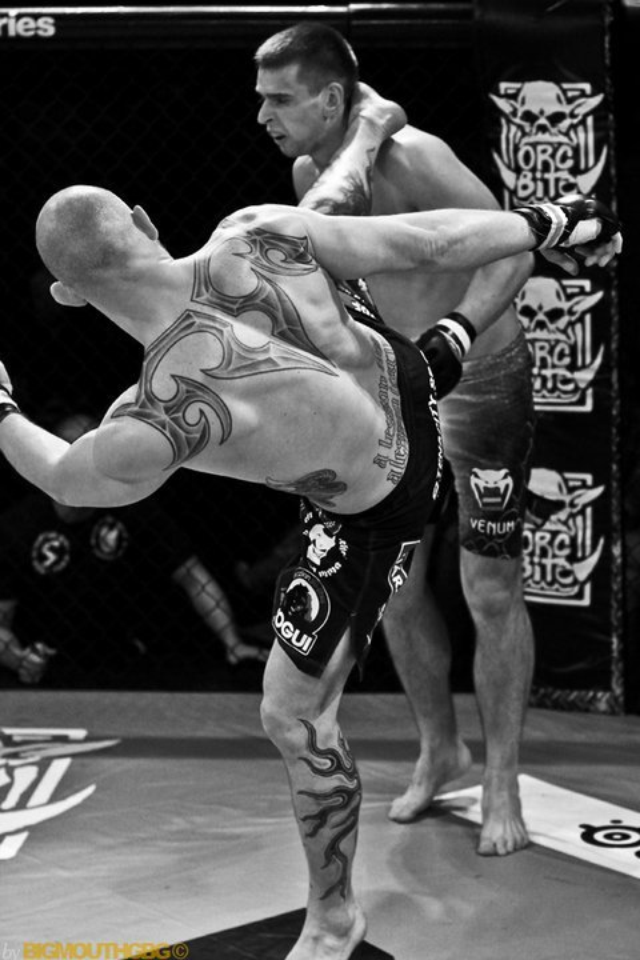Blog
Fighting – Sparring for Krav Maga
First, let’s look at what sparring is, what it should be, how it should be used and what benefit we can reap from it if we use it correctly. In the table you’ll see the different types of sparring we commonly use in Krav Maga Global (KMG), you will also see the different paces, goals, mindsets and at what level that type of sparring is introduced in the curriculum of KMG. Note that in only the first type of fighting (Slow fighting) impact is 100%, which sounds hard but at the pace in slow fighting (20-30%) the impact of the hits will be ok even for a beginner.
| Type | Slow Fighting | Light Fighting | Medium | Hard | Full Contact |
|---|---|---|---|---|---|
| Pace | 20-30% Low | 70-90% Medium/High | 40-60% High | 70-90% High | Maximum |
| Impact (Agreed between partners) | Full Contact | 10-20% | 30-50% | 60-80 % | 80-90% Except to head |
| Goal (Every goal set moves up the ladder) | Understanding movement Learning to see and avoid attacks. Using defenses and attacks in the correct timing. Using correct attacks on different distances. Learning to avoid | Increasing pressure, decreasing response time within a safe environment. Sensitising the CNS for high speed drills. | Adding more pressure, learning to resist impact, learning to avoid impact, learning to resist mental pressure | Adding more pressure, learning to resist impact, learning to resist mental pressure | Functioning under and coping with pressure, (mentally and physically) under as realistic conditions as possible |
| Mindset | Learning | Learning | Learning/Fighting | Learning/Fighting | Fighting |
| KMG Lvl | P 1-3 | P 2-4 | P4 – G1 | P5 – G1 | G1 |
| Gear | Mouth guard, groin protection | Mouth guard, Groin protection, Shin guards, MMA gloves (4 Oz) | Mouth guard, Groin protection, Shin guards, MMA gloves/Boxing Gloves (10 Oz and up) | Mouth guard, Groin protection, shin guards, MMA gloves/Boxing Gloves (10 Oz and up), Head Gear | Full protective, impact reducing suit |
NOTE: The start of different types of sparring can differ from person to person, the table is a recommendation and uses the levels in the curriculum where the type of sparring first appears (Medium fighting was added to give another tool for natural progression and will not be found in the KMG curriculum). Also the percentages of Pace and Impact might vary between practitioners.
I will divide the types of sparring in two main categories
• Sparring/Fighting in training (Mindset: Learning, Learning/Fighting and Fighting)
• Sparring/Fighting for testing/grading (Mindset: Fighting/Learning)
Sparring in training
Mindset: Learning & Learning/Fighting
The overall goal of all the types of sparring in KMG is to prepare the practitioner for real life encounters and at the same time improve certain given qualities. The level of pressure/stress in the sparring should be adequate to the level of the students training together and the qualities the sparring is aimed at.
For instance, if we want a more technical approach where the students have the possibility to explore new techniques that they just have learned, they have to be put in an environment that facilitates that.
If we go back to the chart above we can see that the approach to sparring in KMG is a safe way to gradually introduce sparring at a low pace with minimum pressure to get the students used to the skill of sparring. Additionally, they get the chance to practice their footwork, their attacks and defenses and over all fighting ability under a pressure, that puts them just outside their comfort zone.
This is done to improve their abilities to react to attacks, and to trigger their CNS to work on a little higher level than before the session. If the partner goes too hard and increase the pressure too high, too early in the training, it will trigger the Fight-or-flight response. Due to the release of too much stress hormones, it will turn the focus of the training session into a Fighting session. This in itself is not a bad thing, but at the early stages of learning sparring it will bring the learning and skill acquisition down which in turn hinders the development of the student.
You can’t win a training session!
Think about it, it is a training session with a training partner; a person that you enjoy training with, and probably want to continue training with so that you can both get better and reach new levels together. To make sure that you reach further every session, you have to do something Eyal told me the first time I visited Israel in 1995 – To learn how to fight, you have to invest in loss. Think about it, the more images you give to your brain on what might happen if you do a certain thing, the more resources your brain has to access when it needs it (the process of finding them will also be faster if you have acquired them before compared to responding to a new problem).
To learn how to fight, you have to invest in loss – Eyal Yanilov
Eyal Yanilov
Investing in loss also helps you mentally accepting the fact that you might loose and that understanding will help you to understand your weaknesses, fix the problems and move forward as a better practitioner of Krav Maga.
Except the triggering of the Fight-or-flight response the increased pressure from one of the partners will make the training into a competition, again, this is not a bad thing in itself but for learning purposes it will be less than ideal.
Being a good partner
Regardless of sparring type it is all considered a learning experience and to make sure that it is maximized the partners has to be good partners to each other and help the other person learn as much as possible, at the same time they of course have to focus on improving their own skillset.
This is easily controlled by a simple rule. The partner with the least experience sets the pace and decides the impact for the sparring. This way the pace of the training will be helping both partners as opposed to if the better of the two just does his/her thing and bullies the partner with less experience. The benefit of this is that the partner with more experience gets to try new things and at the same time help bring the less experienced partner to new heights by letting them experience new problems. All of this helps both partners improve their decision making process.
“Learning at the edge of your ability but not beyond, where you are successful but challenged”Gray Cook/Brett Jones, FMS
Stress and the CNS
The further into your sparring training you go the more pressure you can add, which will help you react to problems faster and faster under more and more pressure. The higher you bring your skills on this ladder the easier other things will be.
Let me explain with some personal experience of mine. I had been training Krav Maga and MMA with sparring for a lot of years (KM 1994 – 2010, MMA 1999-2010) before I did my first real fight (Pro MMA), I then did two more professional fights, one in 2010 and one in 2011.
In my fights I realized two main things.
- I understood that I had never tried to hit somebody full speed and full power before and no one had ever tried to hit me full speed and full power before. As we know, sparring in training is never full speed and full power – for safety reasons, and you usually don’t want to hurt your training partner.
- After I had been at full speed and full power, both on the giving and receiving end, my brain had started to work in a higher level when I went back to sparring with partners in a training environment.
Think of it like driving 250 km/h and then reducing speed to 100 km/h, everything will feel much easier since the brain will be used to reacting to problems “attacking it” at a much higher pace. To me this was a very valuable experience in my further development.
Going back to sparring in training … we have to increase the speed and power in training to make sure that we reach a level that is as high as possible without loosing control and safety.
Sparring/fighting is an extremely important tool that can make or break the students and as a tool it has to be used correctly to reach the correct goal. The sparring has to be directed to the goal of the session and above all the experience of the group of students! If the different stages of sparring/fighting types of training is followed in an intelligent way, with a steady increase of mental pressure/intensity/impact/speed, we will build students that will be able to do intelligent sparring/fighting without any injuries and this will help build the best practitioners we can build.
Sparring in testing
Mindset: Fighting/Learning
The sparring in testing is a completely different ballgame than the sparring in training! Here we want to see the overall efficiency and competency of the student in a sparring situation that is as realistic as possible while still keeping safety and control. We do not consider this a Learning/Fighting experience but a Fighting/Learning experience. This is as close we in KMG come to a real fight, this is where we have to put all the training into play and try to win.
What will we look for during sparring on a test?
There are a lot of qualities that we want to see in a student and a few of them are.
- Safety
- Control
- Power
- Speed
- Explosiveness
- Movement
- Determination
- Stamina
- Mental abilities
- Fighting skills
Safety
It goes without saying that safety is a crucial part of all KMG training and especially sparring and fighting!




Pingback: Quels sont les bénéfices du sparring à l'entraînement ? - Krav Maga Blog